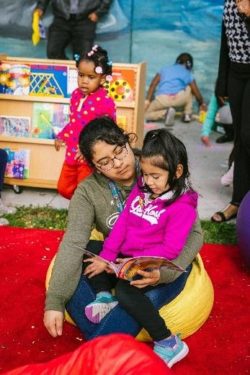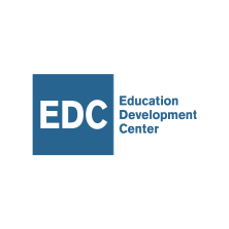COVID-19 forced us all to make big changes, some of which are going to continue beyond the pandemic. This six-part blog series asked six different Family Math organizations how they continued to serve families during the pandemic, and what they’ll keep moving forward.
What is Family Math? Family Math is an emerging movement to promote math activities within the context of family relationships and everyday life, from the grocery store to the playground, during breakfast, bath time or bedtime. The practices help young children strengthen their math skills and feel enthusiastic and confident. It also empowers parents, organizations and early educators with knowledge, tools, and resources that help them feel excited about introducing and exploring mathematical concepts.
This is blog post three of six, and comes from Jessica Young and Kristen Reed at the Education Development Center’s Young Mathematicians in Worcester program (YM in Worcester). YM in Worcester’s goal is to transform the way that educators and families interact with children around math—making it a common and doable family activity. Learn more: www.ym.edc.org
How did your organization support Family Math before COVID-19?
 In 2019, when Young Mathematicians (YM) in Worcester was formed, we brought together early childhood teachers, families, and community organizations to create a web of opportunity, promoting math at home, in schools, playgroups, and libraries—all the places young children live and learn. We worked with our partners to create a Family Advisory Committee (FAC) and provided language interpretation, transportation to the venue, food, and childcare.
In 2019, when Young Mathematicians (YM) in Worcester was formed, we brought together early childhood teachers, families, and community organizations to create a web of opportunity, promoting math at home, in schools, playgroups, and libraries—all the places young children live and learn. We worked with our partners to create a Family Advisory Committee (FAC) and provided language interpretation, transportation to the venue, food, and childcare.
These meetings began with us providing learning opportunities to help families understand early math through hands-on games, as well as a discussion about positive attitudes toward math. Each FAC introduced families to new math games which families then tried at home. At the next session, we collectively discussed what worked well and what was challenging for families to implement and we adjusted materials based on families’ feedback. For example, the FAC suggested that a good way to engage one another would be on Facebook, and we created a private Facebook group for our Family Advisory Committee Meetings.
As families became more comfortable with the math content we were discussing, they began looking for more ways to make everyday moments math moments. We spent time at each session for families to share the ways they had incorporated math into their family’s play, talk, and routines. Families were particularly interested in picture books. Families shared their favorite books and the math they saw in them and how they could engage their child’s interest in math through books. For example, The Berenstain Bears book, Inside, Outside, Upside-down was a favorite. This book is chock-full of spatial relationship language. We played a game based on the book by putting a teddy bear into a box and discussing the perspective of the bear and how spatial relationships are based on where objects are relative to each other in space.
How did you adjust and adapt for COVID-19?
During COVID, we had to pivot and conduct our family meetings virtually. When we were in-person, families had really enjoyed taking home books and materials after each session. This model was much harder to follow during COVID though we were still able to deliver materials to families a few times a year.
Together with families, we came up with ideas about ways to use the things they had around them at home. For example, we created a new game, Laundry Make-5, to target composition and decomposition (addition and subtraction) of the quantity five, using socks that are thrown into a laundry basket. For this game, we discussed questions that got at mathematical thinking such as: Of 5 pairs of socks, “How many landed inside the basket?” “How many landed outside of the basket?” “How many do we have in all?” Additional question ideas included sorting, counting, and comparing attributes of clothing/laundry.
We also developed a session about the math in everyday activities, such as washing and putting away dishes. We discussed ways to compare attributes of dishes and utensils (e.g., round plates), using mathematically descriptive language such as smaller, bigger, longer, wider, and using spatial language when putting dishes away (e.g., “the cups go inside the bottom cabinet”). This session built upon previous sessions and families reported feeling more confident in recognizing mathematical opportunities around them. They also reported noticing that they are engaging in more math with their children.
What were some of your organization’s bright spots during COVID-19?
When in-person preschool for Worcester Head Start Programs and Worcester Family Partnership shut down in March 2020, educators were concerned about how to work remotely with families who depend on their programs. We shared virtual instructional strategies and practices to keep families and their children learning and practicing math at home. To keep track of our meetings together we created an online resource for the course, a Learning Management System (LMS), which we added to our website.
Working closely with our Head Start and Worcester Family Partnership colleagues, we distributed 3,100 kits—with mini-books, sets of “dot cards,” games, and instructional booklets in four languages—to families. Funding for the kits was provided by the Heising-Simons Foundation and Overdeck Family Foundation, and the effort was modeled on a similar National Science Foundation-funded initiative, which reached 400 families in Lawrence, Massachusetts, last summer. We also worked with the Worcester Public Library librarians to develop similar math kits that complimented their virtual programming. These went home to families during the school year and three additional math kits will be going home with families as part of their Summer Reading Kick-off events.
Our goal is to foster positive attitudes toward math and transform the way that educators and families engage children around math—making it a common and doable family activity, so that all children to see themselves as STEM learners. As one of our parent participants, Shemekia Pearson said as she reflected on her experience with Young Mathematicians: “Playing these games was quality time with my child, but it was quality time that I felt was beneficial to his today and his future… I see how confident he is in math, and it makes me feel proud.”
What changes will you keep as you move forward? What are you looking forward to post-COVID?

